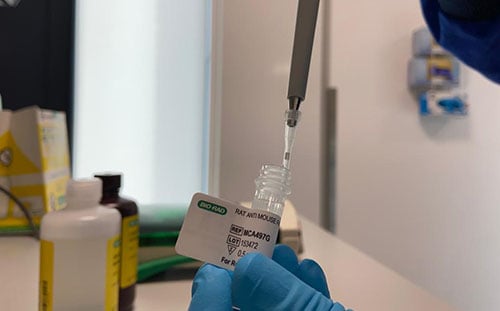
Popular topics

Treat Them Right! – Best Practices for Storing and Working with Antibodies

Incorrect management and storage of an antibody can have a big impact on its performance. This blog discusses some best practices for storing and using your antibodies to get the most out of them in your experiments.
Too Hot to Handle?
You should always refer to product specific datasheet and follow manufacturer’s instructions when it comes to storing an antibody as it is essential that any antibody is stored at the correct temperature. Not doing so may lead to a degradation in performance and invalidate any manufacturer guarantees. Stability at different temperatures largely depends on the format and formulation of the antibody.
Antibodies may also have multiple recommended storage temperatures, depending on the length of time you wish to store them for. For example, the label and the datasheet of most of our antibodies show “+4ºC or -20 ºC if preferred” as the recommended storage conditions. This is because most antibodies can be stored at +4ºC for a short period of time, usually a few weeks, but should be stored at -20ºC long term.
Antibodies supplied lyophilized may have different recommended storage conditions for when they are lyophilized and after reconstitution. If you are working with a lyophilized antibody, check the datasheet for the storage conditions recommended for before and after reconstitution.
Some antibodies only have one recommended storage temperature. For example, antibodies supplied without any antimicrobial agents, such as sodium azide or thiomersal, should only be stored frozen (usually -70ºC or below) to reduce the likelihood of microbial growth.
Serums and ascitic fluids should be stored frozen as they contain proteases which can degrade proteins, including antibodies. Storing frozen helps to minimize protease activity and prevents the antibody from degrading during storage.
In contrast, enzyme-conjugated antibodies, such as HRP-conjugated antibodies, generally should not be frozen. Freezing and thawing these antibodies reduces the catalytic activity of the enzyme, leading to reduced signal when it is incubated with its substrate.
Divide and Conquer
Temperature fluctuations associated with freezing and thawing can lead to denaturation and aggregation of an antibody, impairing its ability to bind to its target. In order to reduce the number of freeze-thaw cycles, antibodies should be aliquoted and stored as per the manufacturer’s instructions. In addition, antibodies should always be stored in the back of the fridge or freezer because this area is less exposed to temperature fluctuations than the front, or the door. You should also avoid storing aliquots in frost-free freezers because they undergo cycles of temperature fluctuation to avoid build-up of ice.
Ideally, each aliquot should contain the volume of antibody used in an experiment and would therefore not need to be refrozen. However, small volumes are more sensitive to concentration fluctuations and evaporation, so it is recommended that the volume should be at least 10 μl.
Antibodies are less likely to degrade or to bind to the vessel wall when stored at high concentration. Therefore, it is not recommended to dilute antibodies prior to aliquoting.
When aliquoting antibodies conjugated to fluorophores or enzymes, it is important to protect them from light. Exposure to light may cause photobleaching of fluorophores or destabilize the structure of the enzyme that the antibody is conjugated to. This would impede the ability of the antibody to yield a signal.
Keep It Clean
It is important that you don’t contaminate your antibody with any substances that may reduce its performance. To avoid contamination of your antibody, it is best to pipette your antibody under aseptic conditions and aliquot your antibody — to reduce the amount of times that you pipette from the same tube.
Take Only What You Need
When thawing an antibody, only take out the number of aliquots you need for your experiment and thaw slowly on ice. Drastic fluctuations in temperature, like warming the vial in your hands, may cause the antibody to destabilize.
If you need to thaw multiple aliquots for the same experiment, make sure that you use aliquots which have been through the same number of freeze-thaw cycles and that you pool the contents of all the aliquots together to ensure that you are working with a homogeneous antibody solution.
It is also important where possible, to avoid refreezing antibodies which have been thawed. Additional freeze-thaw cycles may cause damage to the conformation of the antibody and reduce its ability to bind to its target. If you do find that you have antibody left over from the aliquots you have thawed for your experiment, it is best to keep them in the fridge if they are to be used within the upcoming weeks, or discard them.
Be Cool
Finally, when performing your experiment, it is important that you keep all your antibodies thawed in the fridge, or on ice, until you are ready to use them. This helps to preserve the conformation of the antibody and the ability of the antibody to bind to its target.
We hope that by following these simple tips, you will be able to get the most out of any antibodies you are using in your assays. As always, we wish you all the best with your research.
Want to Know More About Antibody Best Practices?
Take a look at our comprehensive guides covering selecting the right type of antibody, antibody handling and storage conditions, antibody suitability for your target and more.
Discover Best Practice
You may also be interested in...

View more Applications or Tips&Tricks blogs















